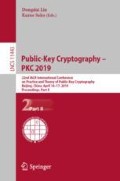Abstract
NTRU lattices [13] are a class of polynomial rings which allow for compact and efficient representations of the lattice basis, thereby offering very good performance characteristics for the asymmetric algorithms that use them. Signature algorithms based on NTRU lattices have fast signature generation and verification, and relatively small signatures, public keys and private keys.
A few lattice-based cryptographic schemes entail, generally during the key generation, solving the NTRU equation:
Here f and g are fixed, the goal is to compute solutions F and G to the equation, and all the polynomials are in \({\mathbb {Z}}[x]/(x^n + 1)\). The existing methods for solving this equation are quite cumbersome: their time and space complexities are at least cubic and quadratic in the dimension n, and for typical parameters they therefore require several megabytes of RAM and take more than a second on a typical laptop, precluding onboard key generation in embedded systems such as smart cards.
In this work, we present two new algorithms for solving the NTRU equation. Both algorithms make a repeated use of the field norm in tower of fields; it allows them to be faster and more compact than existing algorithms by factors \({\tilde{O}}(n)\). For lattice-based schemes considered in practice, this reduces both the computation time and RAM usage by factors at least 100, making key pair generation within range of smart card abilities.
Parts of this work were done when Thomas Prest was an engineer at Thales, and was supported by the projects PROMETHEUS (European Union Horizon 2020 Research and Innovation Program, grant 780701) and RISQ (French Programme d’Investissement d’Avenir, grant P141580).
Access this chapter
Tax calculation will be finalised at checkout
Purchases are for personal use only
Notes
- 1.
All the timings in this document are provided for a MacBook Pro laptop (Intel Core i7-6567U @ 3.30 GHz), running Linux in 64-bit mode.
- 2.
Several techniques (on-the-fly rescaling, computation modulo small primes, etc.) have been proposed to make the extended GCD more efficient (for an overview, see e.g. [9, Chapter 6]), but they result in the same bounds over \(R_f, R_g\).
References
Albrecht, M.R., Bai, S., Ducas, L.: A subfield lattice attack on overstretched NTRU assumptions. In: Robshaw, M., Katz, J. (eds.) CRYPTO 2016, Part I. LNCS, vol. 9814, pp. 153–178. Springer, Heidelberg (2016). https://doi.org/10.1007/978-3-662-53018-4_6
Babai, L.: On Lovász’ lattice reduction and the nearest lattice point problem. In: Mehlhorn, K. (ed.) STACS 1985. LNCS, vol. 182, pp. 13–20. Springer, Heidelberg (1985). https://doi.org/10.1007/BFb0023990. http://dl.acm.org/citation.cfm?id=18858.18860
Bernstein, D.J., Chuengsatiansup, C., Lange, T., van Vredendaal, C.: NTRU prime. Technical report, National Institute of Standards and Technology (2017). https://csrc.nist.gov/projects/post-quantum-cryptography/round-1-submissions
Campbell, P., Groves, M.: Practical post-quantum hierarchical identity-based encryption. In: 16th IMA International Conference on Cryptography and Coding (2017). http://www.qub.ac.uk/sites/CSIT/FileStore/Filetoupload,785752, en.pdf
Cash, D., Hofheinz, D., Kiltz, E., Peikert, C.: Bonsai trees, or how to delegate a lattice basis. In: Gilbert, H. (ed.) EUROCRYPT 2010. LNCS, vol. 6110, pp. 523–552. Springer, Heidelberg (2010). https://doi.org/10.1007/978-3-642-13190-5_27
Cheon, J.H., Jeong, J., Lee, C.: An algorithm for NTRU problems and cryptanalysis of the GGH multilinear map without a low level encoding of zero. Cryptology ePrint Archive, Report 2016/139 (2016). http://eprint.iacr.org/2016/139
Cooley, J.W., Tukey, J.W.: An algorithm for the machine calculation of complex Fourier series. Math. Comput. 19(90), 297–301 (1965)
Ducas, L., Lyubashevsky, V., Prest, T.: Efficient identity-based encryption over NTRU lattices. In: Sarkar, P., Iwata, T. (eds.) ASIACRYPT 2014, Part II. LNCS, vol. 8874, pp. 22–41. Springer, Heidelberg (2014). https://doi.org/10.1007/978-3-662-45608-8_2
von zur Gathen, J., Gerhard, J.: Modern Computer Algebra, 3rd edn. Cambridge University Press, Cambridge (2013)
Gentleman, W.M., Sande, G.: Fast Fourier transforms: for fun and profit. In: Proceedings of the 7–10 November 1966, Fall Joint Computer Conference, pp. 563–578. ACM (1966)
Gentry, C., Peikert, C., Vaikuntanathan, V.: Trapdoors for hard lattices and new cryptographic constructions. In: Ladner, R.E., Dwork, C. (eds.) 40th ACM STOC, pp. 197–206. ACM Press, May 2008. https://doi.org/10.1145/1374376.1374407
Hoffstein, J., Howgrave-Graham, N., Pipher, J., Silverman, J.H., Whyte, W.: NTRUSign: digital signatures using the NTRU lattice. In: Joye, M. (ed.) CT-RSA 2003. LNCS, vol. 2612, pp. 122–140. Springer, Heidelberg (2003). https://doi.org/10.1007/3-540-36563-X_9
Hoffstein, J., Pipher, J., Silverman, J.H.: NTRU: a ring-based public key cryptosystem. In: Buhler, J.P. (ed.) ANTS 1998. LNCS, vol. 1423, pp. 267–288. Springer, Heidelberg (1998). https://doi.org/10.1007/BFb0054868
Kirchner, P., Fouque, P.-A.: Revisiting lattice attacks on overstretched NTRU parameters. In: Coron, J.-S., Nielsen, J.B. (eds.) EUROCRYPT 2017, Part I. LNCS, vol. 10210, pp. 3–26. Springer, Cham (2017). https://doi.org/10.1007/978-3-319-56620-7_1
Micciancio, D., Warinschi, B.: A linear space algorithm for computing the herite normal form. In: Kaltofen, E., Villard, G. (eds.) Proceedings of the 2001 International Symposium on Symbolic and Algebraic Computation, ISSAC 2001, ORCCA & University of Western Ontario, London, Ontario, Canada, 22–25 July 2001, pp. 231–236. ACM (2001). https://doi.org/10.1145/384101.384133
NIST: Security requirements for cryptographic modules (2001). https://nvlpubs.nist.gov/nistpubs/FIPS/NIST.FIPS.140-2.pdf
NIST: Submission requirements and evaluation criteria for the post-quantum cryptography standardization process (2016). https://csrc.nist.gov/Projects/Post-Quantum-Cryptography
Prest, T., et al.: Falcon. Technical report, National Institute of Standards and Technology (2017). https://csrc.nist.gov/projects/post-quantum-cryptography/round-1-submissions
Schönhage, A., Strassen, V.: Schnelle multiplikation großer zahlen. Computing 7(3–4), 281–292 (1971). https://doi.org/10.1007/BF02242355
Smart, N.P., et al.: LIMA. Technical report, National Institute of Standards and Technology (2017). https://csrc.nist.gov/projects/post-quantum-cryptography/round-1-submissions
Stehlé, D., Steinfeld, R.: Making NTRUEncrypt and NTRUSign as secure as standard worst-case problems over ideal lattices. Cryptology ePrint Archive, Report 2013/004 (2013). http://eprint.iacr.org/2013/004
Author information
Authors and Affiliations
Corresponding author
Editor information
Editors and Affiliations
Rights and permissions
Copyright information
© 2019 International Association for Cryptologic Research
About this paper
Cite this paper
Pornin, T., Prest, T. (2019). More Efficient Algorithms for the NTRU Key Generation Using the Field Norm. In: Lin, D., Sako, K. (eds) Public-Key Cryptography – PKC 2019. PKC 2019. Lecture Notes in Computer Science(), vol 11443. Springer, Cham. https://doi.org/10.1007/978-3-030-17259-6_17
Download citation
DOI: https://doi.org/10.1007/978-3-030-17259-6_17
Published:
Publisher Name: Springer, Cham
Print ISBN: 978-3-030-17258-9
Online ISBN: 978-3-030-17259-6
eBook Packages: Computer ScienceComputer Science (R0)

